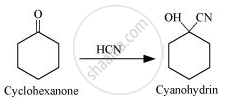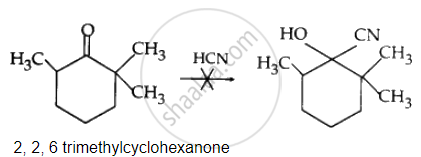Advertisements
Advertisements
प्रश्न
Give plausible explanation for the following:
Cyclohexanone forms cyanohydrin in good yield but 2, 2, 6 trimethylcyclohexanone does not.
उत्तर


Due to the presence of three methyl groups at α-places, nucleophilic attack of CN– ions does not occur. This steric hindrance is absent in cyclohexane. Hence, nucleophilic attack of CN– ions occurs quickly. Hence, cyclohexanone cyanohydrin is obtained in good yield.
APPEARS IN
संबंधित प्रश्न
Arrange the following in the increasing order of their reactivity towards nucleophilic addition reaction:
C6H5COCH3, CH3-CHO, CH3COCH3
Write the products formed when CH3CHO reacts with the following reagents : H2N – OH
Arrange the following compound in increasing order of its reactivity in nucleophilic addition reactions.
Ethanal, Propanal, Propanone, Butanone.
Hint: Consider steric effect and electronic effect.
What is meant by the following term? Give an example of the reaction in the following case.
Oxime
What is meant by the following term? Give an example of the reaction in the following case.
Ketal
What is meant by the following term? Give an example of the reaction in the following case.
Schiff’s base
How are the following compounds prepared?
acetophenone from benzene
Write balanced chemical equations for action of ammonia on - acetone
Write the structure of Phenylmethanamine.
How will you convert sodium acetate to methane?
Acetone, Acetaldehyde, Benzaldehyde, Acetophenone – reactivity towards addition of HCN.
Write a test to differentiate between pentan-2-one and pentan-3-one.
Alkenes  and carbonyl compounds
and carbonyl compounds  , both contain a π bond but alkenes show electrophilic addition reactions whereas carbonyl compounds show nucleophilic addition reactions. Explain.
, both contain a π bond but alkenes show electrophilic addition reactions whereas carbonyl compounds show nucleophilic addition reactions. Explain.
The pH of blood does not appreciably change by a small addition of acid or base because
Which of the following has the most acidic hydrogen?
What happens when propanone is treated with CH3MgBr and then hydrolysed?

The product "P" in the above reaction is:
The increasing order of the following compounds towards HCN addition is:
| (i) |  |
| (ii) |  |
| (iii) |  |
| (iv) |  |
In the following reaction
\[\ce{Carbonyl compound + MeOH <=>[HCl] acetal}\]
Rate of the reaction is the highest for ______.
Draw the structure of the following derivative.
The ethylene ketal of hexane-3-one
